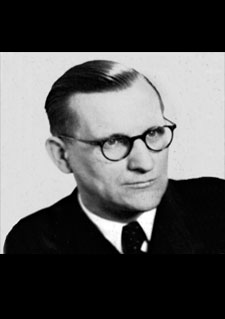Karl Nagengast: Saving People with Disabilities
Karl Nagengast (1909–1987) had started out in 1932 as an assistant pastor in Unteraltheim and then served as a city vicar in Würzburg. On April 1, 1935, he became the director of Nuremberg’s city mission. The change in staff at the city mission also entailed an (ecclesio-) political change: Whereas the previous director Hans Baumgärtner (1892–1943) had been a member of the German Christians and the NSDAP, Nagengast was a member of the Confessing Church.
Despite all of the Nazi’s efforts to curtail the city mission’s work more and more and take over its operations, Nagengast was able to develop new fields of work such as care for the mentally ill, a midnight mission, the creation of clerical jobs for ex-convicts and the opening of homes for women and girls.
Over time, Nagengast’s social work brought him into contact with more and more people who did not meet the standard of the “racial national community”, including so-called non-Aryan Christians in 1935 at the latest. They already assisted Nagengast on their own initiative before the establishment of a regional church aid agency in January of 1939. A short time later, Nagengast started speaking out on the issue of euthanasia.
Early in 1941, Bavarian pastors such as Siegfried Büttner (Ursheim) or Julius Kelber (Treuchtlingen) had drawn attention during church services and at urn burials to the euthanasia program and the transgression of the fifth commandment (Kirchliche Lage II, 368, 372). What is more, the large number of urn of murdered individuals prompted the church government to regulate them in several circulars to parish pastors from December of 1940 onward. These letters contain echoes of von Galen’s sermons and mention Schloss Hartheim euthanasia center explicitly.
Critical statements were not enough for Karl Nagengast following such deeds. He learned at a diaconal conference in 1941 that the ongoing euthanasia of people with incurable illnesses and disabilities since 1939 would soon also threaten the Pestalozzi Home in Nuremberg of which he was also in charge. The transfer of fifteen mentally ill, elderly residents had been ordered over the telephone. Putting in a forceful personal appearance, Nagengast managed to get someone to talk with him at the Health Office.
Upon being informed that the transfer had been settled, Nagengast, invoking the fifth commandment, explained that he would forbid the sisters to assist the removal of people with disabilities in any way. Threats of adverse consequences for the city mission and him personally left Nagengast, who was employing biblical arguments, unimpressed. His proposal that the city mission relieve the government of the cost of room and board and bear them fully itself resulted in the tabling of the problem for several days pending a decision from the Ansbach district government.
Before this meeting, an anonymous individual – later identified as the head of the Nuremberg Health Office – had informed Nagengast about applicable laws. Nagengast in turn countered the authorities’ incomprehension of his resistance with a biblically grounded reference to the Christian duty to aid the weak. Since the Inner Mission and regional consistory helped Nagengast meet the demand to produce a declaration that the church would assume the cost for the threatened individuals’ room and board with utmost speed, the people with disabilities were left in peace.
Nagengast resigned from his job at the city mission in 1941. Serving as a medic, he was called to a parish in Cham in 1943 where he became dean in 1951. Nagengast was sent as Germany’s representative and church councilmember to the Lutheran World Service, the relief and development arm of the Lutheran World Federation, in Stuttgart in 1953. He returned to work in the Bavarian church in 1960 and became a dean in Kempten.
Source / title
- © Archiv der Stadtmission Nürnberg

